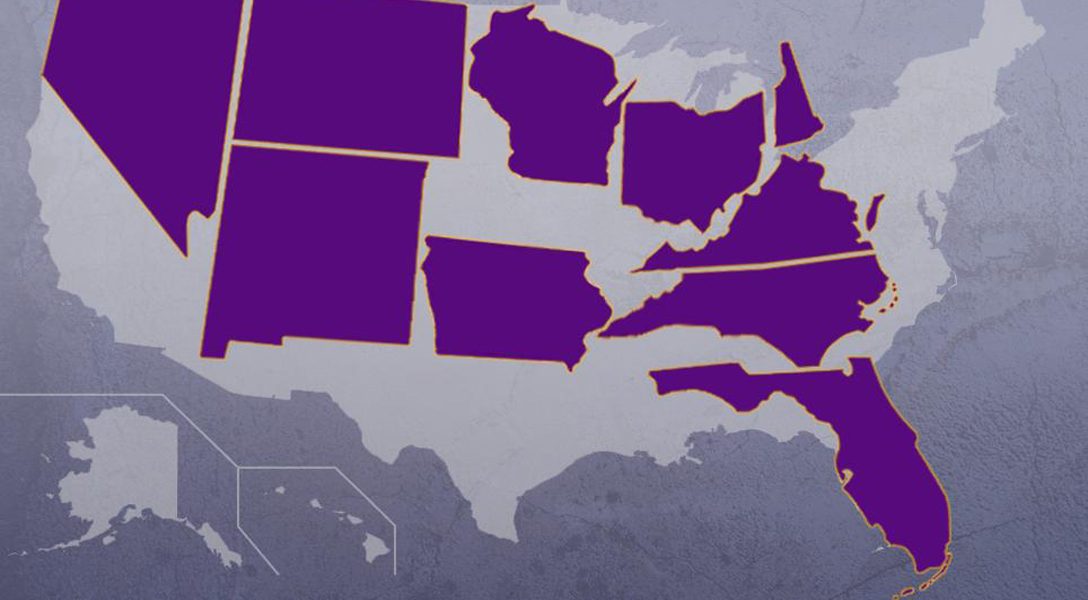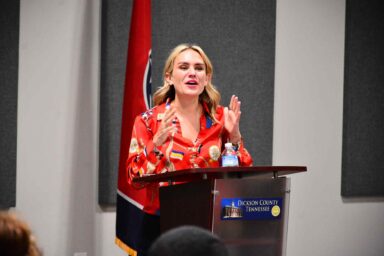A Small Minority in 10 States Will Elect the Next President
Why 40 States Are Irrelevant to the Electoral Process
Even in a close presidential race, candidates need only campaign in 10 “purple” states to optimize their chances of winning. So how healthy is this for our democracy?
When Richard Nixon ran for president in 1960, he vowed to visit and campaign in all 50 states. The strain of that effort, particularly in an era of slower air travel, exhausted Nixon and was in part responsible for his poor appearance — and performance — in the crucial first TV debate with JFK.
Today, with so many states falling into the solidly blue or solidly red column, there are only 10 states that are realistically in play. Not surprisingly, these “purple” states get the most attention in a presidential race.
In fact, throughout the 2012 election cycle, President Barack Obama and GOP nominee Mitt Romney campaigned in only 12 states. Thirty-eight states, from New York to California, had not a single campaign visit after the nominating conventions.
Elections expert David Schultz tells WhoWhatWhy’s Jeff Schechtman that, with the electorate so polarized and the margin for victory in the Electoral College so thin, the outcome will probably be decided by just 10 percent of the voters in those 10 purple states.
The actual roster of swing states may change over time, according to Schultz. For instance, Indiana was safely red four years ago, but is now purple.The former swing state of Missouri is now solidly red. But the basic principle holds: the vast majority of American voters are effectively disenfranchised by the current electoral system.
Click HERE to Download Mp3
Full Text Transcript:
Jeff Schechtman: Welcome to Radio Whowhatwhy. I’m Jeff Schechtman.
When Richard Nixon ran for president in 1960, he vowed to visit and campaign in all 50 states. The strain of that effort particularly in an era of slower air travel exhausted Nixon and was even in part responsible for his health in the first debate with JFK. The reality is today with our nation so divided, with red and blue states pretty much settled, that the purple states, those in play, those that make a difference, are only a handful. If all the candidates did is campaign in ten states, that would be enough to capture the election. So how healthy is it for our democracy that only ten states matter? And will either party want to do anything to change it? We’re going to talk about this today with our guest David Schultz. He’s a professor of political science at Hamline University and he’s taught classes in American Government and Election Law for over 25 years. He’s the author of Presidential Swing States. David Schultz, thanks for joining us here on Radio Whowhatwhy.
David Schultz: Thank you for having me today.
Jeff Schechtman: Great to have you here. There was a time when candidates like Nixon back in 1960 thought it was important to travel the country. Nowadays, not so much.
David Schultz: Not so much anymore, you’re right. From a democracy point of view, if you’re hoping that there’s something called consent of the government, you’d kind of think maybe we ought to travel or presidential candidates ought to travel the entire country, and visit and talk to people. But we know that’s no longer the case. And just to give you an idea, back in 2012, once the conventions were over; the Republican and Democratic National Conventions were over, there were only 12 states that received any visits from the presidential candidates or their surrogates. It’s a very small number. And, most of the listeners can probably guess who they are. Places like Ohio received 73 visits, Florida, 40, Virginia, 36, Iowa, 27, Colorado 23. And you work it down to a few states like Minnesota, they got one, Michigan, one, but for the most part, 38 states didn’t receive a visit whatsoever. And push it further, I would argue that over the last several elections and going into 2016, the presidential election is over in 40 states already.
Jeff Schechtman: The only exception to that seems to be when candidates go to California or New York, or even Republican candidates going to Texas because they’re there for fundraisers, because that’s where the money is for them.
David Schultz: Correct, yes. In terms of showing up to states where they have rich donors, or good pockets of money, you’re correct. But in terms of looking at campaign events, in terms of where they’re actually out there asking for votes, and the critical part is post-convention. Because we will see candidates before the convention, obviously during the primaries and caucuses visiting the states, but once it gets to the post-convention in the middle of a campaign, time is of essence. You know, it is less likely that a Democrat will go, even to California or to New York, simply because they got to conserve their time. And so, that’s why you’ll see, for example like in my home state, right now Minnesota, Hillary Clinton came last week to visit the state, partly because it’s a primary or caucus state. Ask for the money now, tie down the support now, because assuming she gets the nomination in September or October, she’s not going to have time to come here. She’s going to have to spend all of her time in Ohio and Florida.
Jeff Schechtman: How did we get to this point? When was the tipping point?
David Shultz: Well, there’s a couple. So there’s two questions there. You know, one is the how or the why, and the how or the why is the fact that in 48 out of 50 states in the United States, the state legislatures have chosen to allocate the electoral votes on a winner-take-all. And by that, in those 48 states, Maine and Nebraska being the exception, in the rest of the states, whichever candidate wins the most votes in the popular vote gets all of the electoral votes in that state. That’s one, and the second issue is, and we’ve seen that it’s over a 20-year period, a 20-25-year period, is the increasing polarization across states. And combine, sort of this winner-take-all provision with the electoral college, with what I call sort of a geographic and partisan overlay, you know, in terms of how the math puts out. That produces some very, very safe Republican states, and some very, very safe Democratic states. And this is a phenomenon that we’ve really seen emerge over about the last 7 or 8 elections. Maybe we can push it back and say that back in the 1960s, when Nixon ran, that we had more states that were up for grabs. But it really is, and I’d say the last quarter century or so, that we seem to be down to a finite number of states that we classify as the swing states.
Jeff Schechtman: Of course it is the electoral college system itself that lies at the core of this issue.
David Schultz: Correct. Correct. Because of the fact that we don’t have a popular election for president. I mean one of the things that people often times don’t realize, and we learn this in Bush vs. Gore, back in 2000, first is that it is not a direct popular vote that determines who wins the presidency. At the end of the day, it’s what I call the Race to 270. It is the race to win 270 electoral votes. That’s what you need to become president of the United States. And that means then we have not a national election for president, but a 50 state election where each of the 50 states is a separate contest for president. So first, the popular vote, really, I don’t want to say doesn’t matter, but to some extent, it really doesn’t matter. And then the second thing that we learn from Florida 2000 is that we still do not have a constitutional right to vote for the president of the United States, that the electoral votes and how they are going to be allocated is ultimately under the control of the state legislature and is merely from the grace of let us say, the legislature, the governor of California, that they let us go vote to determine how the electoral votes will be allocated in California. Otherwise, the legislature could say “we’re going to come up with a new system,” but you’re right. The electoral college is the core problem here. Again, along with the fact that we have this geographic partisan overlay.
Jeff Schechtman: And it’s interesting when we talk about shifting demographics, and we look at the way the population is shifting today and moving to more urban areas and hollowing out some rural areas. It’s really interesting to see the way that is playing out in particular states.
David Schultz: Absolutely correct. We like to talk about red and blue states across the country and purple states, but even within particular states, there are enclaves of areas that are strongly Democrat or strongly Republican. And the number of areas in states that are, let’s say, purple, is actually quite small. And we see this across the country now, where we really do have, this geographic separation. Part of, I hate to use the word, sort of great insight. I won’t use the word genius because people overuse the word genius, but part of the great insight that Karl Rove had back in 2004 when he was working for George Bush, was to realize that we had this geographic separation in the United States, that increasingly people want to live with other people who share their political views. The Democrats want to live with Democrats. And Rove figured out that if we combine voter turnout results with marketing data; what cars we drive, what restaurants we eat at, what clothes we wear, combine those two together, and we could target very precisely how to get out the vote efforts and to message to potential voters. And so that shows us the degree to which we’re really seeing this separation where we can say for example if I live in an urban area, and I drive a particular type of car, one can make a pretty good prediction regarding how I’m going to vote.
Jeff Schechtman: When we look at the ten states that are the purple states, the swing states, Colorado, Florida, Iowa, Nevada, New Hampshire, New Mexico, North Carolina, Ohio and Virginia, what do we learn about those states and about their ability to shift from one side to the other in each election.
David Schultz: There’s a few things that separate them out from the rest of the states. First, these are states where neither the Democrats nor the Republicans form a majority, and that makes sense. And so, they are states where roughly we see, Democrats and Republicans in some type of parity. Maybe they’re both about 30 to 40 percent of the population, roughly in that area, or how they identify themselves. Second, these are states that a large percentage of the population also identifies themselves as moderate or as independent in the sense of: they don’t consider themselves affiliated with either the two major parties. A third characteristic that we find for these states is that these are states that have many political regions in them. For example, we hear of “seven Floridas,” you know, seven different media markets down there, or the “multiple Ohios” where Cleveland versus Columbus versus Cincinnati, are very different regions, creating different bases of political support for Democrats and Republicans. And so, there are some general characteristics that are out there, and then I think the other characteristic, which is pretty important too, is what’s called sort of the median political voter, or median voter in a state. If we were to look at the average voter in that state, and how they line up; how liberal they are or how conservative they are, generally what happens is that the median voter in that state is to the right of recent Democratic presidential candidates or to the left of recent Republican nominees. And therefore, these are average voters who find the Democratic candidates too liberal or the Republican candidates too conservative, and therefore, there’s some evidence, perhaps of swinging, or some evidence of choosing to vote or not to vote. And those become the characteristics, among a couple of others, that really define these states. It would be too easy simply to say, well, there’s something unique about all these states, you know, there’s something about the culture. There actually are some cultural variables for each of these swing states, but we did find some common characteristics that I just described.
Jeff Schechtman: Can we narrow it down even more? To bring it back around to Richard Nixon, it was Nixon that said on one of the tapes, “it always comes down to Ohio, dammit!”
David Schultz: Actually, we can. Now, I like to talk about how really presidential campaigns come down to three sets of numbers, and I call them 10, 10, 270. Now, 270 refers to the fact that you need 270 electoral votes to win. 10 refers to the ten swing states. We also know, within those ten swings states, we can cut it in two different ways. That there are roughly only about ten percent of the population that swings, and they actually less swing, than is the issue of if they decide to vote or not vote. And so one way to describe it is: ten percent of the population within ten states determine who gets 270 electoral votes, and the presidency. That’s one way to describe it. The other way to describe it is that within those ten swing states, we found that there are certain counties that are important. For example, in Florida, Hillsborough County, which is where Tampa and Tampa Bay are located, it seems usually whoever wins that county wins the state of Florida. By coincidence, it’s also Hillsborough County in New Hampshire, and in Colorado, it is Arapahoe and Jefferson Counties, but the single most important county in the United States is Hamilton County, Ohio, where Cincinnati is located. Essentially, whoever wins Hamilton County, Ohio wins Ohio. Whoever wins Ohio wins the presidency. Now, we’re not down to the point of saying, you know, whoever Harry and Louise vote for in Hamilton County, Ohio determines the presidency, but this is how micro we’re getting in terms of being able to show, on one level, how the balance of power for presidential races hinges upon very small numbers of people.
Jeff Schechtman: Is there a danger for candidates and their handlers of over analyzing this data? Can you get it to the point where you focus so much, for example, on Hamilton County, Ohio, that you lose sight of other situations in the other nine swing states, and that it does skew the results because of that?
David Schultz: Yes, there’s no question about it. When I wrote this book and I think the opening line of the book is to say that the presidential race is over in forty states, and you might as well stay home if you’re one of those forty states. That’s an exaggeration. Obviously, if you ignore your base; if Democrats or Republicans take for granted that they can win California, or Texas or in New York, then they are in danger of losing those states. And it’s the same thing, if you focus solely upon just the narrow band of individuals, let’s say, the Arapahoe County or the Hamilton County, Ohio, you may be losing track of that broader base, and you may be tailing your message so narrow, that you lose support of many people who you nonetheless still need to win that state, or win the presidency.
Jeff Schechtman: What about the fact that there are still aspects of the country, I know it seems hard to imagine, even in these ten states, but there are still attitudes that are shifting, there are still circumstances that are shifting, you know, we talk about Hamilton County, Ohio, you know, we can look at what happened to John Boehner or essentially congressmen from part of Hamilton County, and wonder what that means in the larger scope of the way things are changing?
David Schultz: Yes, good point. Nothing is static. And I think the 2016 presidential race actually speaks to this exceedingly well; is that if we were having this conversation, let us say, five months ago, we would have said that it looks pretty certain that the nominees for the two major parties are going to be Jeb Bush and Hillary Clinton. Well, now, put us several months away, and it looks in that it might be Donald Trump and perhaps, well, it looks like Clinton is solidifying her lead now. A few weeks ago, Bernie Sanders was making a clear challenge to her and still might be able to break through in some places. And the point that I’m getting at is that political parties are not static; that as we see new people enter our political system, things change. For example, I talk about in the book, how there really is a generational shift going on in America in politics; that a generation of people who are born between 1924 and 1945, they’re called the “silent generation.” They are largely, I’ll say nicely, exiting the political system, being replaced by millennials; those born between 1982 and 2000. With that, a shift in political values going on. We also can see how events in the world, you know, changes in the economy can change people’s perspectives or political alignments. Political scientists like to talk about a phenomena called critical realignments, where parties change like how people’s political allegiances change. And I say that because while we can say, to some extent, that we’ve had for the last seven elections, roughly the same ten states as the critical swing states, things can happen. You know, 2016, all things being equal, we still think those are the ten swing states, but a Trump candidacy, a Clinton candidacy, perhaps another major terrorist attack could change the dynamics of politics in such a way that the exact number of swing states changes or some swing states shift comfortably into the safe, and some safe shift out. For example, looking at just simply demographics: Democrats look at the state of Texas, for example and say that as the Hispanic population continues to grow there, it becomes a greater percentage of the electorate. At some point, perhaps, Texas becomes a competitive Democratic state. Same thing with Georgia. 15 years ago, very few people thought Virginia or North Carolina were competitive for Democrats. And so, factors change and that’s what we should always keep in mind.
Jeff Schechtman: It’s interesting to see the way some of these swing states, which were purple states in the sense that we’re talking about them, are becoming particularly polarized within the states themselves.
David Schultz: Yes. Yes.
Jeff Schechtman: Virginia being, perhaps, the penultimate example of that.
David Schultz: Yeah, there are several good ones. I would say Florida is very good, Ohio is very good in terms of examples. That’s the other thing to point out here. In all those swing states, there seems to be some clear region of differences. And again if I can just use Florida, because I think it’s a good example here; Florida has sort of the southeast coast, the Dade County, Miami County, with the West Palm Beach area, for example, areas heavily populated by people formerly from New York’s strong liberal Democratic enclaves. On the other hand, go to the Panhandle of Florida, solidly, solidly Republican. And then the same thing we find in Ohio and a few other states too where we’ll see clear areas where there are concentrations. And if we did not have the electoral college, or if the electoral college in those states didn’t allocate winner take all, you might see a Florida, you might see an Ohio where Democrats win about half the electoral votes, or Republicans win about half the electoral votes, and we might even see, even in states like California, where in places like Orange County, for example, where there are enclaves of very strong Republican votes, you might see presidential candidates come out there and campaign for votes.
Jeff Schechtman: See, it’s interesting to watch how all of this shifts, and it’s also interesting to look at what would make a more profound difference and outcome. If we were to essentially, not that this is going to happen, but eliminate the electoral college and just determine by popular vote, or keep the electoral college, and have proportionality, as they do in Nebraska for example. Which would have a more profound effect on the outcome?
David Schultz: I think totally eliminating the electoral college will have a more profound effect in the sense that at that point, you might encourage candidates to campaign in more states. Now, the proportionality might also do the same thing, but I do think at the end of the day, from what I would call, a democracy argument, I think at the end of the day, most people in the United States, if you ask them “what’s the fairest way to elect the president of the United States?” I think they would say, majority rule. And I think that’s the foundation of what American democracy is about, and I think that would carry both more symbolic and real legitimacy in terms of a transformation or importance to American society, and still saying at the end of the day, that its proportionality in fifty separate races across the United States.
Jeff Schechtman: The irony that’s inherent in that, and I don’t want to get too inside baseball about this, is that I would argue that Republicans would probably benefit the most in a national election from eliminating the electoral college, given demographic trends and if you were to do it on a straight popular vote. But yet they would be the most opposed to this idea because it is antithetical to the Constitution, to the founding fathers, and it would be very hard get the courts to be supportive of it. So those that would benefit from it the most, arguably, would wind up being on the wrong side of the issue.
David Schultz: And you may be correct. The one caveat that I would throw in is that they would benefit correctly, you’re correct, under current voting patterns, and I say current voting patterns where people of color and the poor are far less likely to vote. If we were to have a voting system for example, where we had higher percentages of, again, of the disaffected voters. And again, it’s usually people of color, usually poor people voting, then it would be a system that probably would benefit Democrats. But clearly I think there’s a good point to be made here; is that with the current restrictions in place, whether it’s voter ID, registration laws or just simply in many situations where some people are so worried about their day to day existence in terms of getting by, they don’t think about voting. This change would actually benefit Republicans. And again, in states like New York, and states like California, which are so overwhelmingly Democratic right now, that Republicans would probably benefit if they could go into those states and ask for votes.
Jeff Schechtman: Whereas Democrats would benefit from greater proportionality, I would argue.
David Schultz: That’s a possibility too, because in some of those states, and again, if we look at a lot of states in the south, take places like Louisiana, Alabama, Mississippi, Georgia, even though they’re strong Republican states, there are urban areas within all of those places. You know, we have the Atlantis, we have New Orleans, which are overwhelmingly Democrat and so, you would see Democrats picking up quite a few electoral votes across those areas. And given the fact that there are more people living in urban areas in the United States now, and actually for a long time than in rural areas, such a proportionality would work to the benefit of many Democrats.
Jeff Schechtman: Are there new states? Do you see in the next election cycle, or the one after that, I don’t want to look any further than that, but 2016 maybe going into 2020, any shift in the ten states that are in play? I mean, do you see any of these ten solidifying either red or blue, or perhaps others that will move into the purple column?
David Schultz: Okay first, I see New Mexico, which has been a swing state for quite a few election cycles, moving out of being a swing, and moving solidly into a Democratic camp. And so, that’s one that moves out. We used to know that for example, that Missouri, which was a great swing state, and for over a hundred years, it was almost a perfect predictor, has moved from swing to becoming Republican. Now, if I’m looking to the future, the two, perhaps three states that I think that fit a category of entering swing, one would be Georgia. Georgia used to elect Democrats, moved Republican, but in the last election, with running former Senator Sam Nunn’s daughter as a Senator, it showed that it can be competitive, perhaps as a Democratic state, you know, the demographics moving there, I see Georgia as one. I see Texas as another state, not so much in ’16, but maybe 2020 or 2024 as having a growing Hispanic population, that potentially produces it as a competitive swing state. And then Indiana, which did vote for Barack Obama in 2008, and it went back to voting Republican in 2012. I see that as another possibility in terms of a shift over time. And so, those would be “my states” in the immediate crystal ball. Now, were there to be a Trump candidacy this year, Trump candidacy could very well affect, in lots of different ways. And so, we would want to see if it is a Trump versus a Clinton campaign, where those candidates have passionate supporters and passionate distractors. That candidacy, or that contest, could open up different states to the next two.
Jeff Schechtman: What’s changing in Indiana that you think leads that to be more of a swing state?
David Schultz: One of it is that we have the western, private Indiana, which is right along the border near Chicago, a very large population of Democratic voters. And in 2008, Barack Obama specifically targeted those voters, and the Republicans weren’t paying attention to it, and he targeted and mobilized them, and they turned out and voted for him to help him win. And remember, and Obama was a Senator from Illinois. And in 2012, Obama didn’t target Indiana, and the Democrats lost it. But there is, between Indianapolis, a Democratic city, or a significantly strong Democratic city, and in the western part of Indiana, a large population of Democrats that are generally un-mobilized. Put those two together. If the Democrats can figure out how to, with a different candidate, mobilize and target those voters, we might see Indiana move into a possibility of being swing. But that, a lot of has to do with how successful Democrats are in terms of doing mobilization.
Jeff Schechtman: And Missouri, you don’t see as a swing state anymore?
David Schultz: It doesn’t appear to be anymore. That, again, for a hundred years, Missouri predictably went with the winner every time. The only election it missed was in 1956, I believe it was, where Missouri voted for Adlai Stevenson instead of going for Dwight Eisenhower. Up until, I think it’s through 2000, it was a perfect predictor. And in 2004 and 2008, it started losing that prediction, and it shifted. It shifted because that state has become more conservative, and also I think because the Democrats have been nominating candidates more liberal than the average voter in that state. So the combination of the two, I think has really pushed Missouri out of the category, at least for the near future, in terms of being a swing state.
Jeff Schechtman: When you look at this, before I let you go, there is something that is really antithetical to democracy about the whole thing. I mean, you start to zero in on this, and it’s fun to talk about, and it’s interesting from a political perspective, but there is something about it that is kind of depressing within the context of thinking about democracy.
David Schultz: Yes. And again, if I come back to the notion of saying that democracy is about the consent of the government, it is about the fact that our most important political position, the country, should represent all of the people. When we’re down to a situation where it is really only a few people in a few states that really matter in terms of who really gets the presidency. It’s down to a few states for candidates’ campaigns. And even between campaigns, we know that these are the states that also just proportionally get more money from the president, and more attention. This really undermines a sense of democratic legitimacy; the idea that your vote really matters, your voice really matters. And that’s the disconcerting part. From a tactical point of view, that’s one thing. Tactically, understanding how to run a campaign for the presidency is one thing, but this phenomena of swing states, I think undermines this broader and deeper notion, again, for lack of a better word, about what a democracy and what makes legitimate democracy.
Jeff Schechtman: And I guess the biggest beneficiary finally is potential vice presidential candidates that come from many of these swing states.
David Schultz: Well the true beneficiaries, first, are the vice presidential candidates, and two, it is the local television stations in those states, because we know that presidential elections, about 60 to 70 percent of the money that goes into a presidential race turns around and goes back into, mostly television, although some radio advertising. And so those states receive a disproportionate amount of that money in terms of advertising. And so, as I like to tell my students sometimes, I kid and say “I’m in the wrong business. I should be selling airtime in Ohio or Florida.”
Jeff Schechtman: David Schultz, his book is Presidential Swing States: Why Only Ten Matter. David, I thank you so much for spending time with us here on Radio Whowhatwhy.
David Schultz: Thank you very much!
Jeff Schechtman: Thank you, and thank you for listening and joining us here on Radio Whowhatwhy. I hope you’ll join us next week for another Radio Whowhatwhy podcast. I’m Jeff Schechtman.
If you like this podcast, please feel free to share it, and help other people find it by rating and reviewing it on iTunes. You can also support this podcast and all the work we do by going to whowhatwhy.org/donate.





